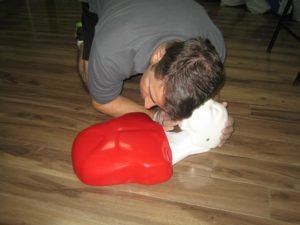In cases where an individual is injured in an accident, the first thing to do is to check that you or other bystanders are not in any danger. If the area appears unsafe, make sure that the scenario is safe. Once it is safe to enter the scene, you have to assess the casualty and call for emergency assistance and while waiting for the medical team to arrive, you have to perform first aid.
How to assess an injured individual after an accident?
During the assessment of the victims after an accident, always prioritize ABC – airway, breathing and circulation.
Airway
In case the injured individual appears unresponsive, you have to ask him/her loudly if he/she is okay and if capable of opening the eyes. While waiting, check the breathing, level of response and pulse rate.
When there is no response, do not move the individual and try to open the airway. If this is not possible in the current position of the individual, you have to gently position him/her with the back on the ground and open the airway.
Open the airway by placing one hand over the forehead of the individual and tilt the head gently back then lift the tip of the chin with your two fingers. In doing so, this will move away the tongue from the rear part of the mouth. Avoid pushing on the floor of the mouth since this will cause the tongue to block the airway. If a spinal injury is suspected, position your hands on either side of the face and use your fingertips to lift gently the angle of the jaw to open the airway. As much as possible, do not move the neck of the individual. This is called as the jaw thrust maneuver and you can learn this in any first aid course.
Breathing

You have to determine if the individual is breathing by checking if the chest is rising and falling, listen over the nose and mouth for breathing and feel his/her breathe against your cheek. If the individual is breathing, place him/her in the recovery position so that the airway is free from obstructions. In case the individual is not breathing, call for emergency assistance and then perform CPR.
Circulation
Once the heart ceases to beat, you can maintain the circulation by delivering chest compressions. The technique is called a cardiopulmonary resuscitation (CPR) if performed with rescue breaths.
For those who are not trained to feel unable to deliver rescue breaths, you can perform compression-only CPR. Take note that during the initial minutes after a sudden cardiac arrest, agonal breathing is quite common. This is rapid, intermittent gasps of breath must not be considered as normal breathing. CPR must be carried out right away.
Always remember that in any emergency scenario; always prioritize the airway, breathing and circulation in order to assess the condition of the individual.
